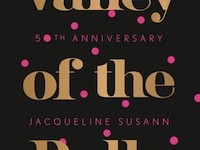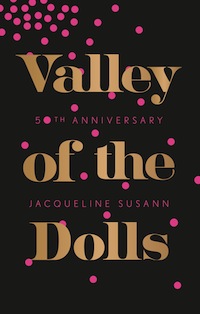editor's choice

ALL OF US HAVE A FIRST FORBIDDEN BOOK – the one that we never forget, the one that sat so enticingly on the top shelf far out of the reach of small hands. In my case, it was Jacqueline Susann’s  Valley of the Dolls, a big fat white elephant of a book that called to me from between Delta of Venus and Tropic of Capricorn. Of course, I had to read it and yet, when I did, most of it passed over my innocent 11-year-old head. But that thrill of reading something illicit, something that’s forbidden – well, you never really forget that feeling. And so, there’s a huge amount of pleasure in rereading Susann’s best-selling novel – actually Virago’s specially produced 50th-anniversary sparkly black-and-pink edition.
Valley of the Dolls, a big fat white elephant of a book that called to me from between Delta of Venus and Tropic of Capricorn. Of course, I had to read it and yet, when I did, most of it passed over my innocent 11-year-old head. But that thrill of reading something illicit, something that’s forbidden – well, you never really forget that feeling. And so, there’s a huge amount of pleasure in rereading Susann’s best-selling novel – actually Virago’s specially produced 50th-anniversary sparkly black-and-pink edition.
A tale of sex, drugs and the modern woman, Dolls, arguably, has as much, if not more resonance today than it did when it was first published in 1966. An almost immediate success, one which Susann, a self-styled publicist, worked hard to achieve, Dolls sat on the New York Times best-seller list for 65 weeks, 28 of those in the No 1 slot (1966–7). And to date, the book has sold more than 40 million copies in 30 foreign editions; no mean feat, even in modern publishing terms.
Susann’s protagonists, educated and classy Anne, talented Neely and beautiful Jennifer, navigate the tough world of post-World War II America, using their looks, bodies, sex and drugs (the ‘dolls’ of the title) to get what they want. Each recognizes the limitations placed on them by their society and each comes to acknowledge the weaknesses and fallibility of the men around them, who, at various points in their lives, they also exploit, in turn. The ‘dolls’ – uppers and downers – help Susann’s characters get through the day (or not), although they could also be seen as a reference to how women are perceived in a society that ultimately values them only in terms of their beauty and youth. In Susann’s world, the women become savvy, often coming to recognize their worth through bitter experience: and, in the end, they may have to compromise, they may not get their hearts’ desire, they may not even be happy, but they are still far stronger and, in many ways, more realistic than the men around them, even those they love most.
On one level, the book is a pulpy salacious extravaganza, featuring characters who inhabit the glitzy, glamorous and often sordid celebrity postwar worlds of New York, California and Paris, and who bear more than passing resemblances to Hollywood and pop icons of the past, including Judy Garland, Marilyn Monroe and Dean Martin. On another, it’s a cultural history of an America in transition, when the postwar optimism of the late 1940s, when anything seemed possible and permissible, gave way to the freedom, excesses and cynicism of the early to mid-1960s. And yet, many of Susann’s themes – that women are valued by their looks and age, that celebrity is what most people seek and exult in, that men are often feckless and that we all seek love – are ones that run true today, particularly in our ’15-minutes-of-fame’ culture.
Valley of the Dolls may not be a typically happy-ever-after novel; it may even be slightly tawdry and unapologetically trashy, at times, but it is extraordinarily enjoyable, possibly because there’s no artifice or artistry in Susann’s writing – what you see is really what you get.
There’s no resolution for any of the characters and even Neely, who is extremely successful, has to change to maintain and protect her position, backstabbing and betraying those she once loved and thus becoming the embodiment of every thing she so despised at the beginning of her career. Anne and Jennifer, while both are loved and love, do not fair well by comparison. Thus, in some ways you could almost read Dolls as a morality tale – a ‘be-careful-what-you-wish-for’ kind of story.
If you haven’t read Valley of the Dolls (and even if you have in some younger incarnation), please do. It’s definitely worth a (re)visit and it does improve with age. Regretfully, unlike the kitschy synthesized 1967 film adaptation, starring Barbara Parkins (Peyton Place), Patty Duke (The Patty Duke Show) and the extremely ill-fated Sharon Tate (Roman Polankski’s wife, murdered by Charles Manson’s followers), which is very pretty admittedly, but rather vacuous. Please someone remake it. The book deserves a far better cinematic fate.
Valley of the Dolls by Jacqueline Susann • 30 June 2016 • Virago • Paperback anniversary edition •
Image credits: Please note that any images are intended to be used for promotional purposes only. If there are any problems, please do contact us. Virago cover: courtesy of Helen Upton, Little, Brown Book Group, whom we also thank for the book; Jacqueline Susann standing by the New York Times best-seller list from www.valleyofthedolls.com (estate of Jacqueline Susann).
Also of interest:The Splendour of George Stevens’ Giant (1956); Chris Whitaker’s mad, mad world – Tall Oaks; Ralph Ellison’s Invisible Man (1952) – E. McNight Kauffer (book covers we love); ‘How Penguin learned to fly – Allen Lane and the Original “Penguin Ten”‘; ‘An Alaskan Epic – Rosamund Lupton’s The Quality of Silence‘; ‘The beauty of Sara Taylor’s The Shore, a breathtaking debut’, ‘“Amethyst and flowers on the table”, the beauty of Sufjan Stevens’ Carrie and Lowell, a review‘.
This review is © 2016 by The Literary Shed. All opinions are our own. All rights are reserved. We welcome your feedback and comments, so please do contact us or fill in the form below. If you wish to reproduce this piece, please do request permission. Thank you so much.


